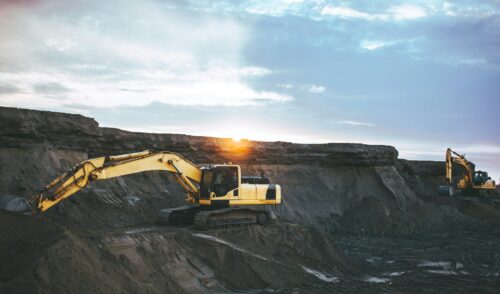
Solid Foundation for Future
back to contentsConstruction works at all four Akkuyu power units are going as scheduled. In early December, workers finished installing the main components of the reactor pit, a dry shield and a support frame, at Unit 4. They will ensure maximum reliability of the reactor operation.
Each of these reactor pit components was installed using a heavy crawler crane. The entire process took eight hours.
“The installation of the reactor support frame and dry shield belongs to the project milestones scheduled for 2024. Installing such large-size structures is a complex, extremely demanding process, requiring the highest qualified personnel and the most precise accuracy. The experience gained by our staff from doing the same job at the earlier built power units enabled them to complete the installation on time. We continue to work intensively on the construction of the reactor pit at the fourth unit of the plant,” said Sergey Butskikh, CEO at Akkuyu Nuclear.
The dry shield is a thick-walled cylinder-shaped steel structure filled with special-grade concrete resistant to high temperatures (up to 500 °C). Surrounding the reactor pressure vessel, it reduces thermal loads and ionizing radiation exposure on the concrete reactor pit. The dry shield makes it possible for the reactor to operate even under extreme conditions, for example, in an earthquake with a 9 point intensity on the MSK 64 scale. Being 6.7 meters in outer diameter and more than 5 meters high, the entire structure (excluding the concrete filler) weighs 30 tonnes.
The support frame secures the reactor pressure vessel in the concrete pit and reliably protects the reactor from external impacts. Weighing 145 tonnes (excluding the filler), it has an outer diameter of over 10 meters and a height of over 1.5 meters.
Workers continue to build the reactor pit at Unit 4, concreting its cavities and installing control channels.
Akkuyu is not Rosatom’s only project with several power units being built concurrently, in a conveyor-like fashion. Two VVER 1200 reactors are simultaneously under construction in each of Bangladesh and China. Four similar units are being constructed in El Dabaa, Egypt. In late November, installation of a molten core catcher, or melt trap, at Unit 4 of the Egyptian nuclear power plant. Hungary, which operates four power units with VVER 440 reactors, plans to pour the ‘first concrete’ for the fifth and sixth units with VVER 1200 reactors as soon as next year.
Six power units with VVER 1200 reactors are currently in operation: two at each of the Novovoronezh and Leningrad nuclear power plants in Russia, and another two at Astravets in Belarus.
Best staff for the first power station
Akkuyu Nuclear keeps training engineering personnel for the Turkish nuclear power plant. In late November, 42 students holding bachelor’s degree from Turkish universities were enrolled on a three-year master’s program at the National Nuclear Research University (MEPhI, Rosatom’s backbone university) and the Moscow Power Engineering Institute (MPEI).
Students were selected based on their academic performance and the relevance of their prior degrees. Every candidate was interviewed by the MEPhI and MPEI academic staff. The students will major in Nuclear Physics and Technology, Electrical Engineering and Technology, Thermal Engineering and Technology, or Nuclear Power Engineering and Thermal Physics.
 Before their program started, the students had a meeting with the representatives of Akkuyu Nuclear and the universities. They were told about the curriculum, internship, and working conditions at Akkuyu Nuclear. The meeting was joined by the graduates from the Akkuyu NPP Operating Staff Training Program, who shared their experience of studying at Russian universities.
Before their program started, the students had a meeting with the representatives of Akkuyu Nuclear and the universities. They were told about the curriculum, internship, and working conditions at Akkuyu Nuclear. The meeting was joined by the graduates from the Akkuyu NPP Operating Staff Training Program, who shared their experience of studying at Russian universities.
“We continue to meet our obligations under the intergovernmental agreement to train operating personnel for the nuclear power plant. More than 300 qualified engineers have graduated from the program to date. All of them are employed either in the project team or on the construction site of the Akkuyu NPP and gaining one-off experience, which they will be able to use for the benefit of their country in the future. Deep theoretical knowledge of engineering disciplines allows Turkish professionals to be active contributors to the project and win prestigious professional awards,” Sergey Butskikh said.
The professional training program for the Akkuyu personnel was launched in 2011. Training is tuition-free for the would-be Turkish engineers and is covered by the Russian government. Akkuyu Nuclear pays scholarships to its future employees, provides visa support, covers medical insurance and annual flight costs to Russia and back.
Talking about atoms
One of Rosatom’s primary missions is to raise awareness about nuclear power and radiation technologies. In November, Rosatom organized screenings of Oliver Stone’s documentary Nuclear Now at three Turkish universities (Sinop University, Ankara’s Haci Bayram Veli University and Tarsus University). The documentary took its director three years to make. The movie talks about the importance of nuclear power in creating a clean and sustainable future. “Having watched the movie, I now understand what nuclear power is, how this industry has evolved and what progress it has made throughout its history. The movie helped me gain ‘atomic’ awareness,” Zeynep Nisa Şirin, a logistics student at Tarsus University, shared her impressions.
 Two universities also hosted the Global Atomic Quiz, an educational initiative of Rosatom, after the movie screening. This year’s quiz was held both online and offline, with about 25,000 people from 100 countries taking part.
Two universities also hosted the Global Atomic Quiz, an educational initiative of Rosatom, after the movie screening. This year’s quiz was held both online and offline, with about 25,000 people from 100 countries taking part.




